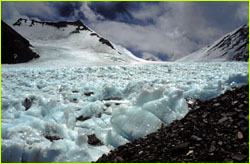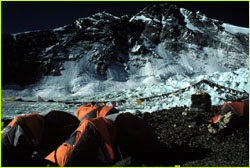 |
 |
 |
by Liesl Clark May 11, 1999 Angled rocks anywhere from the size of your thumbnail to the size of your house make up the terrain from Base Camp to Advance Base Camp. It is not your usual walk—more like preventative stumbling. Just six weeks ago, we were only able to hike to Interim Camp, also known as Yak Camp—a mixture of rock, tents, hay and dung—at 19,000 feet in an effort to acclimatize slowly to the thinner air. We then moved up to Camp II, nestled on the moraine between 60-foot ice pinnacles. But today we were able to bypass our early camps, moving from 17,000 at Base Camp to 21,300 feet in a single day. Palatial rock towers look down upon us as we stumble across the impossible terrain, drunk from high altitude and the fatigue of walking eight hours uphill. We're really walking on ice covered in rock—most footsteps placed uphill slide back down, revealing the black ice underneath. It's like the Bruce Springsteen song: "One step up and two steps back." The spring thaw is in full swing, and glacial ice melting into streams can be heard flowing within the hollows of the glacier. The rock moraine, which is our only means of passage, carves a narrow corridor between two seas of blue ice towers. Everest looms overhead, its image reflected in the occasional melted ice pond, like a tidal pools from the ancient Tethys Sea which once covered the Himalayas.
A frozen mist swirls around us as we stagger in to camp. Eric Simonson, Dave Hahn and Thom Pollard are waiting around the radio to hear news from the North Col. Three Ukranian climbers have been caught out for two nights after successfully reaching the summit. One has died, one has returned to camp, and the third has been plucked from his bivvy spot at about 27,200 feet, severely frostbitten on his face and legs, snow blind, and unable to walk. Conrad Anker, Jake Norton, Tap Richards and Andy Politz have climbed to the North Col to assist in lowering him down the ropes in a litter. What follows is cameraman Thom Pollard's account of the rescue. The Rescue by Thom Pollard The stars shined brightly through the fading glow of my headlamp. Sparkles of snow glistened like diamonds, floated onto my face and melted there. In front of me stood the faint outline of Chomolungma: Everest. If not for the rescue taking place above us I might have remarked that there could not have been a better night for climbing. However, at that very moment, my teammates Conrad Anker, Jake Norton, Tap Richards and Andy Politz, along with several climbers from other expeditions, were lowering a badly frostbitten Ukranian climber down the steep fixed lines of the North Col. Our job was to meet them at the bottom of the lines and whisk the patient, all wrapped up in a sled, down to Advance Base Camp, 1,000 feet in elevation below. Early on the morning of May 8, three Ukranian climbers had set out for the summit. We watched from our Base Camp telescope as three tiny figures moved slowly up the route. In worsening weather and without the aid of supplemental oxygen they moved on, reaching the summit shortly after noon, Nepal time. We were sure they were in for trouble, as clouds obscured our view of the route. By early evening, with dark setting in, none of the climbers had arrived at their tents. A fight for life was taking place high on the mountain, and there was nothing we could do but wait. One of the climbers was still not accounted for. We could only presume the worst. The decision to hike up to the North Col from ABC came late on the evening of May 10. Comprised of Italians, Ukranians, teammate Dave Hahn and I, Sherpas, Tibetans and led by New Zealand guide Russell Brice, this last phase of the rescue held with it the responsibility of carrying our fellow climber from the base of the North Col (about 22,300'), to Advanced Base Camp at about 21,300'. We departed at 11:30, thinking that by the time we reached the base of the Col, Anker and crew would be finishing their job on the fixed lines. Lowering the patient from the North Col (23,100') down the fixed lines required the rescuers to use all their technical climbing and rope handling skills. Anker, Norton, Richards and Politz were assisted by a strong Italian climber, Silvio, who works rescue near Monte Rosa in Italy. Using a rope approximately 200 feet long, the rescuers started by setting a firm anchor into the snow and ice, directly above where they wanted to lower the patient. The rescue sled, attached to one end of the rope, could then be lowered by feeding the rope through the anchor. A special type of resistance knot makes the lowering easier, allowing the rescuer at the top to brake or stop the lowering with relative ease, but also to feed the rope through without diluting all his strength. In this case, two climbers worked the rope from the top, lowering slowly, as two or three other rescuers climbed down with the patient, calling out on the radio when to slow down, or when to speed up. The rescuers going down with the patient always fastened themselves into the existing fixed lines, or to the rescue rope, to insure that a fall didn't harm them. After four separate set-ups, the rescuers were at the bottom of the Col, ready for relief from our waiting crew. Our main foe? Darkness. The rubble and rocks making up the lateral moraine present an aggravating problem on a warm, sunny day. Now we faced the challenge of trying to time the steps of eight climbers hanging onto a sled containing the body of a man in need of immediate help. Medical attention and a warm tent awaited the patient. There was literally no time to lose. When we met the advance rescue crew at the bottom of the fixed lines I was moved at the sight of another of the Ukranian climbers, who had been working to lower his friend from Camp VI at over 27,000 feet for more than 48 hours! We all consider Roman to be our friend, as we'd climbed side-by-side with him and his team since the beginning of the expedition. Roman was covered in frost, and his eyes contained the blank stare of someone in need of rest and warmth. Despite his condition, he refused to let me take his pack, and wanted only to get on with the rescue after a warm drink. It took some time to get into the rhythm of carrying the sled down the rocky slope. Occasionally one of us would stumble, but the others would hold steady. The patient was obviously in pain, and tried to pull himself up to a seated position during our infrequent stops. Any aching in my arms or legs seemed so insignificant when I considered the condition of our patient. His friends kept saying, "Just twenty minutes. Twenty more minutes!" And barely a whisper came from him. We were all aware that he wasn't out of danger. At one point, I looked back and noticed Roman taking one of the carrying positions on the sled. Of course, his pack was still on. Something very powerful was obviously driving him. The sight of him helping, on the edge in his own right, will always be an inspiration to me. In any event, there were several spare rescuers, including those who'd done the lowering from the Col. With coaching from Russell, one or two lighting the path ahead, and the rested rescuers switching out with the tired ones, we made good progress down the moraine. I wish I could say we made for a smooth ride. After more than an hour of stumbling and shifting positions, easing our way down the lateral moraine of the East Rongbuk Glacier, we could make out the faint outline of Russell Brice's Advanced Base, lit up and ready to accept our patient. "Almost there, you guys." By then, it was nearly 2:30 am. After nearly three hours round trip from Advance Base Camp, our fellow Ukranian climber was in the hands of his doctor. Today we learned that his blood pressure was 60-over-20 when he arrived, with a pulse of 60. This morning he's shown much improvement, and we hope he'll be healthy enough to withstand the long trip back to Base Camp, carried by a team of yak herders, and then home. Our team of climbers depart tomorrow from Advance Base Camp for the North Col, weather pending. This is the first step in their long journey to the top of the world. Check back in daily as we report on their summit climb. Unanswered Questions (May 25, 1999) Forty-Eight Yaks (May 21, 1999) On Top of the World (May 17, 1999) Summit Team Moves Higher (May 16, 1999) Still at Camp V (May 15, 1999) Snow Bound (May 14, 1999) Outsmarting the Weather (May 13, 1999) Last Trip Up (May 12, 1999) Up to ABC/The Rescue (May 11, 1999) The Image of Mallory (May 8, 1999) In Extremis (May 7, 1999) Pieces of the Puzzle (May 6, 1999) Dearest George (May 5, 1999) Mallory's Discoverers Return (May 4, 1999) Mallory Reported Found (May 3, 1999) Waiting in Silence (May 1, 1999) Up to the Search Site (April 30, 1999) To the North Col (April 29, 1999) Waiting out the Wind (April 28, 1999) Search About to Begin (April 25, 1999) Pitching a 1933 Tent (April 23, 1999) Early Camp Found at 21,750 Feet on Everest (April 20, 1999) Up to Base Camp (April 23, 1999) Photos: (1,2) Liesl Clark; (3) Ed Webster. Members of the press: click here for NOVA/PBS ONLINE "Lost on Everest" media relations contacts. Lost on Everest | High Exposure | Climb | History & Culture | Earth, Wind, & Ice E-mail | Previous Expeditions | Resources | Site Map | Everest Home Editor's Picks | Previous Sites | Join Us/E-mail | TV/Web Schedule About NOVA | Teachers | Site Map | Shop | Jobs | Search | To print PBS Online | NOVA Online | WGBH © | Updated November 2000 |
 The surreal terrain surrounding Mount Everest.
The surreal terrain surrounding Mount Everest.
 Advanced Base Camp
Advanced Base Camp